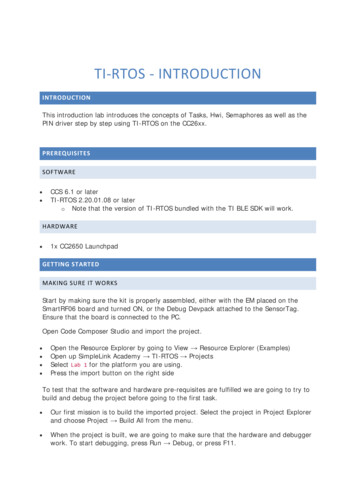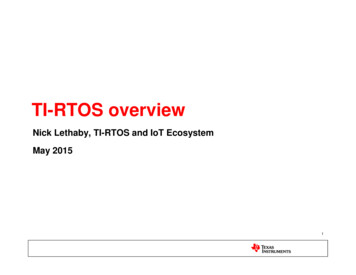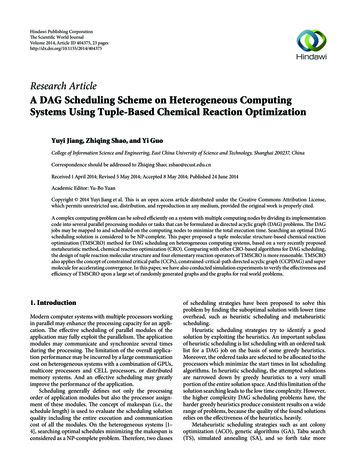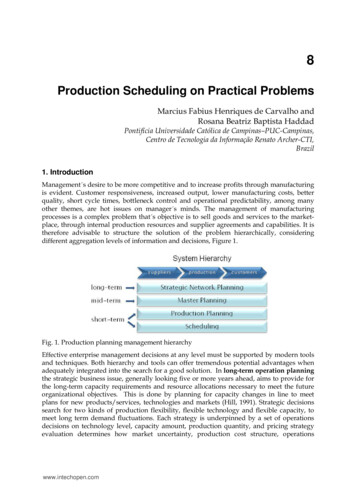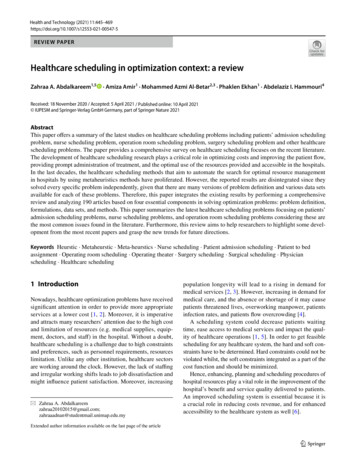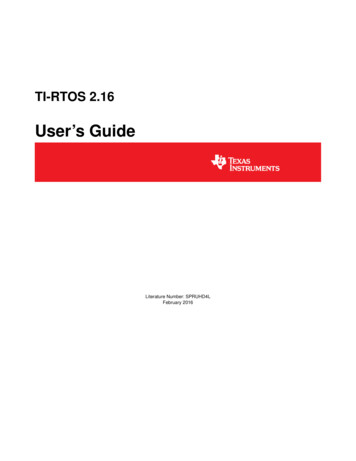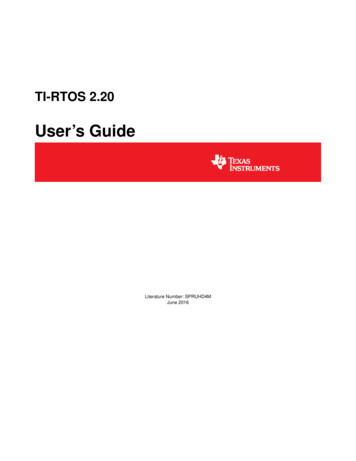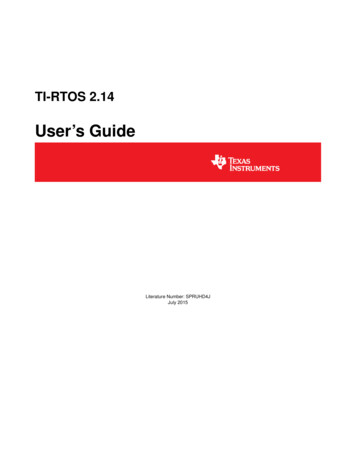
Transcription
Indian Institute of Technology BombayCS684/CS308 Embedded Systems LabScheduling in TI-RTOSE.R.T.S. Lab1Lab Objective Analysis of time driven scheduling using the game console and TI-RTOS. Identifying tasks and implementing scheduling strategies. Understanding advantages of RTOS over sequential execution of code.2Pre-requisite Lab5: Interfacing GLCD. Lab6: Installing TI-RTOS. Basics of Real-time operating systems. Scheduling in Real-time operating systems.3Background MaterialYou will be give a test code (gameConsole.c) which interfaces all the available peripheralson the game console.1. Four push buttons.2. One shoot button with joystick.3. Four leds.4. Analog potentiometer (up-down direction of joystick).5. One buzzer.1
6. One graphics LCD.The test code tests the board in the following way: Four push buttons are used to test the four Leds. When you long press the switch,one led corresponding to it with will get lit. The shoot button of the joystick is used to turn on the buzzer. When you long pressthe shoot button the buzzer turns on. The joystick (up-down) decides the delay between the two successive images on theGLCD. In our case its the cheetah animation. Its speed changes when you hold thejoystick at either ends.Observe the output of the code on the game console. Study the code and reason out whywe need to long press any switch to observe the output.4Problem StatementWrite the RTOS version of the gameConsole.c code using TI-RTOS. The expected outputis that you no longer need to long press the switches to observe the output. You shouldobserve the LED output in real-time; without causing a lag on the GLCD. We will analyzehow this can be done in the following sections.5AnalysisHere is how we can go about it: Let us say that we divide the entire code into three major tasks.– Task 1: Read the five switches(four push buttons plus shoot button) and updatethe leds and buzzer.– Task 2: Read the ADC value and update the delay to change the speed ofanimation.– Task 3: Update the image on the GLCD. For the purpose of analysis, let us assume that task 1 takes 20 ms to execute, task 2takes 30 ms to execute and task 3 takes 100 ms to execute. Draw a time-line, if we were to implement this in sequential manner. X-axis will bethe time in ms and Y-axis will be task that is being run. What will be range in timein which the switch presses will go undetected. Now, for implementing it in RTOS, we need to decide at what time you should schedulethe tasks, with what period, so that the when you press the switch it should be detectedwithout causing a lag on the GLCD screen. Note: TI-RTOS uses a preemptivescheduler. As there are three tasks we can give them a priority. Decide a suitable priority foreach of the tasks. Generally, a user expects that action of pressing the switch getinstantaneously reflected on the output. In our case leds and buzzer. Keep this inmind while deciding the priority.2
We will create three tasks and three semaphores corresponding to the three tasks.After deciding the time when we should release the semaphores you can start writingthe scheduling strategy.6Procedure Create a new project (non RTOS project) and include the gameConsole.c code in theproject. Build and compile the code. You will need the image files that you used in Lab 5(Available on the course web page(part3)). Study the code and observe output. Observe thebehavior of the switches. Complete the tasks that has been described in the analysis sections based on yourobservations. Complete the analysis, you should have the scheduling strategy ready with you beforeproceeding further. Now to begin the RTOS experiment, go to projects examples RTOS for Tiva C browse to the empty project and include it in the work-space. Replace the code in the empty.c file and with the code in the gameConsoleRTOS.cfile. There are some missing parts in the code. Read through the code and completeit. It is related to the scheduling strategies that we have analyzed earlier. Note: If you get an error in the line#include "inc/hw gpio.h" replace it with#include inc/hw gpio.h and vice versaThey seem to be the same but sometimes there are issues while porting from linux towindows and vice versa. If you do not get an error then ignore this step. Add the image files one.h, two.h . to eight.h to the project. (Lab 5 part 3) There will be a empty.cfg file in your project. Right click and open the file withXGCONF. You should be able to see the following windows.3
Note(for linux): If you get an xdctools error while opening the config file. Rightclick: on your project select properties general properties RTSC tab andselect a different version of XDCtools. Once the GUI for the config file is open, first go to the outline window and selectHwi(ti.sysbios.hal). You have to add an instance for Hwi for timer 2A. We will usethis timer to trigger the tasks. Name the handle as Timer 2A INT and ISR functionas Time ISR and interrupt number 39. Keep rest of the settings as default. This isshown in Figure below.4
Go to task in the outline windows and create instance for 3 tasks with the followingdetails:– Handle: readADCtask Function: readADC– Handle: readSWITCHtask Function: readSwitch– Handle: updateGLCDtask Function: updateGLCDPriority for the three tasks has to be decided by you. Enter the suitable values in thepriority field. Refer figure below.5
Go to semaphore in the outline window and create three binary semaphore keepingrest of the settings to default with following details– Handle: ADCsem– Handle: GLCDsem– Handle: SWITCHsem Now read the code and fill the timer interrupt ISR depending upon your schedulingstrategy. Find out the timer period from the timer init function. We have defineda variable called tickCount. This is incremented in the timer ISR. You can use thisvariable to decide when to release the semaphore. The syntax for the same is given inthe comments section. Writing the scheduling strategy involves checking the tickCount variable and realizingthe semaphore related to a particular task. Each task created and is ready to execute. TheSemaphore pend(ANY SEMAPHORE, BIOS WAIT FOREVER);blocks the task. Until it gets a semaphore it will stay there forever. To release a semaphore useSemaphore post(ANY SEMAPHORE);7Demo and SubmissionsThis exercise is a lab cum assignment.You have to show the output of the test code using RTOS where the leds and buzzer willrespond to the switches in real-time without any lag seen on the animation on the GLCD.We will accept the assignment part on Moodle. The assignment should contain: The time-line of the three tasks executed sequentially (ref analysis section). Mention the priority that you used for the three tasks. Justify why you assigned aparticular priority to a particular task. Explain your implementation and scheduling strategy in the document in detail. Also, mention if the switches respond in real-time if you implement the test code usingRTOS. Was there any lag observed on the GLCD ?Pleas upload a single PDF on Moodle. You can work in a team for the lab part butupload individual documents on Moodle for the assignment part.6
Scheduling in TI-RTOS E.R.T.S. Lab 1 Lab Objective Analysis of time driven scheduling using the game console and TI-RTOS. Identifying tasks and implementing scheduling strategies. Understanding advantages of RTOS over sequential execution of code. 2 Pre-requisite Lab5: Interfacing GLCD. Lab6: Installing TI-RTOS. Basics of Real-time operating .
